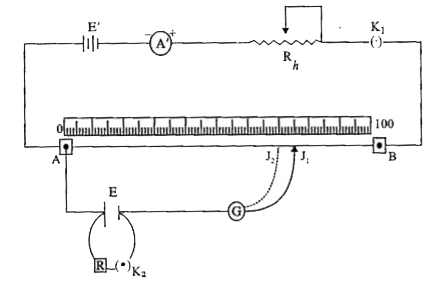With the help of cicuit diagram , explain the use of potentiometer to measure internal resistance of a given primary cell ?

To find the internal resistance of a cell of e.m.f . E using potentiometer , set up the circuit as shown above.
Here E. = be the e.m.f.of the battery .
A . = be the ammeter connected in series .
Rh= Rheostat (used to adjust the suitable constant current)
(K1andK2) = be the keys used to switch ON or OFF the circhuit .
G= be the galvanometer
R= be the resistance box .
Close key K1 and maintain suitable constant current in the potentiometer wire with the help of rheostat Rh . Now by moving jockey J on the potentiometer wire , find a point where galvanometer shows no deflection .Let it be when jockey is at J1 . Note the length AJ1=l1 of the wire .Potential differnce across the A and J1 is equal No current flow
∴ According to principle of potentiometer ,
E=Kl1 ..... (1)
Take out suitable resistance R and close key K2 . Again move jockey and find a point where galvanometer shows no deflection let it be at Jockey J2 Note the length AJ2=l2 .
∴ According to principle of potentiometer ,
V=Kl2
Dividing (a) and (2)
EV=Kl1Kl2
EV=l1l2
Internal resistance of the cell
r=(E−VV)×r=(EV−VV)R
r=(EV−1)Rr=(l1l2−1)R
From above it is clear that .If we know the values of l1,l2andR ,Internal resistance (r ) can be calculated .
Similar Questions
Write the principle of working of a potentiometer. Describe briefly, with the help of a circuit diagram, how a potentiometer is used to determine the internal resistance of a given cell.
View SolutionWrite the principle of working of a potentiometer. Describe briefly, with the help of a circuit diagram, how a potentiometer is used to determine the internal resistance of a cell.
View Solution
Knowledge Check
Internal resistance of primary cell depends on :–
Anature of electrolyteBarea of plates immeresed in the electrolyteCConcentration of electrolyte and distance between the platesDall the above
State the working principle of a potentiometer. With the help of the circuit diagram explain how a potentiometer is used to compare the emfs of two primary cells. Obtain the required expression used for comparing the emfs.
View Solution(a) State the working principle of a potentiometer. With the help of the circuit diagram, explain how a potentiometer is used to compare the emfs of two primary cells. Obtain the required expression used for comparing the emfs.
(b) Write two possible causes for one sided deflection in a potentiometer experiment.
View SolutionWith the help of circuit diagram, explain how a meter bridge can be used to find unknown resistance of a given wire?
View SolutionName the device used for measuring the internal resistance of a secondary cell.
View SolutionState the principle of potentiometer. With the help of circuit diagram, describe a method to find the internal resistance of a primary cell.
View SolutionState the principle of potentiometer. With the help of circuit diagram, describe a method to find the internal resistance of a primary cell.
View SolutionTo Measure Internal Resistance Of A Cell|Questions
View Solution
